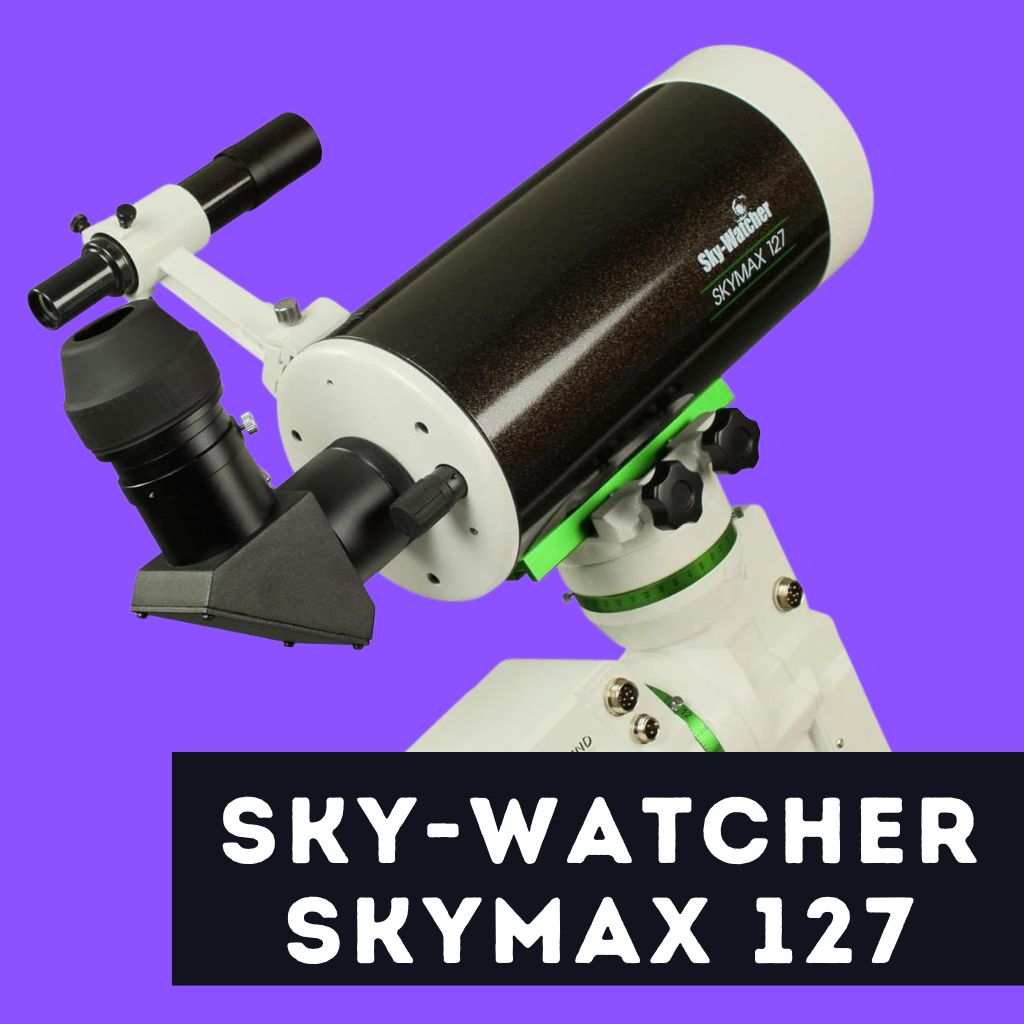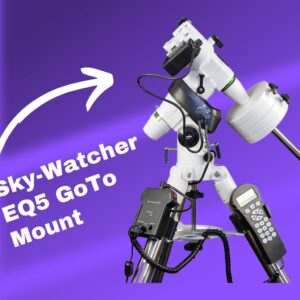This site contains affiliate links to products. I may receive a commission for purchases made through these links.
The Sky-Watcher Skymax 127 Telescope, renowned for its compact and portable design, offers a remarkable combination of power and convenience for both amateur and experienced astronomers.
Understanding the key features and performance of the Sky-Watcher Skymax 127 Telescope is crucial if you are considering purchasing this telescope.
This post will provide an in-depth review of the Sky-Watcher Skymax 127 Telescope, exploring its optical capabilities, portability, ease of use, and overall performance.
Sky-Watcher Skymax 127 Telescope in a nutshell
The Sky-Watcher Skymax 127 Maksutov-Cassegrain Telescope is a well-crafted instrument that excels in offering brilliant astronomical observation and imaging opportunities.
Its long focal length and sharp optics, neatly bundled in a compact and portable design, make this telescope an asset for anyone drawn to astronomy.
The telescope’s unique design, which includes a thick corrector plate and a secondary mirror, also reduces the effect of stray light, contributing to a more enjoyable and immersive observing experience.
This is particularly useful when observing the bright stars, planets, and the full moon, where undesired light can otherwise affect the viewing quality.
The Sky-Watcher Skymax 127 is a versatile, user-friendly, and reliable telescope that delivers a top-tier viewing experience without burning a hole in your pocket.
What can you see with the Sky-Watcher Skymax 127 Telescope?
With the Skymax 127, the night sky’s delights unravel in remarkable clarity. The scope’s high contrast and sharp detail offer you a peek into the following:
Lunar
Viewing the full moon through the Skymax 127 is an exhilarating experience. Its high-contrast optics render the lunar surface in striking detail, revealing the complex network of craters, valleys, and mountains on the moon.
Planets
The telescope’s long focal length scope and design make it a perfect tool for planetary viewing. From the cloud belts of Jupiter to the rings of Saturn, Skymax 127 brings the solar system’s planetary detail into sharp focus.
Deep sky objects
Not just confined to our solar system, the Skymax 127 offers a glimpse of deep-sky objects. From the mesmerizing swirls of distant galaxies to the dense heart of globular clusters, this scope provides a window to the universe’s farthest reaches.
Is the Sky-Watcher Skymax 127 Telescope suitable for beginners?
The Sky-Watcher Skymax 127 Telescope proves to be a good fit for beginners. Its easy setup, intuitive operation, lightweight alt-azimuth mount, and comprehensive accessories make it accessible for those just dipping their toes into astronomy.
However, factors such as cost, maintenance, and the need for potential additional accessories should be taken into account by amateur astronomers.
Is the Sky-Watcher Skymax 127 Telescope good for astrophotography?
The Sky-Watcher Skymax 127 is a capable tool for astrophotography. Its Maksutov-Cassegrain design, long focal length, and the ability to maintain sharp detail over the entire field make it an excellent choice for capturing bright stars, lunar details, and planetary details.
However, for deep-sky astrophotography involving most galaxies and nebulae, it might not be the best choice. Its narrow field and long focal ratio limit its capacity to capture wide fields of view.
Nonetheless, the telescope’s inherent sharp optics and high contrast, combined with a well-performing camera, can deliver good results for bright deep-sky objects.
You may also like: 15 Best Telescopes for Astrophotography (with camera)
Pros of the Sky-Watcher Skymax 127 Telescope
Here are some of the pros of this telescope:
Long focal length
The Skymax 127 has a long focal length of 1500mm, offering exceptional magnification capabilities. It provides detailed views of the moon, planets, and bright deep-sky objects.
The long focal length scope makes it an ideal choice for lunar and planetary viewing.
Compact and lightweight
The telescope comes in a compact package, making it portable for astronomy enthusiasts on the go.
With its lightweight alt-azimuth mount, it’s easy to transport and set up in different locations, making it a perfect companion for stargazing trips.
High-quality optics
The Sky-Watcher Skymax 127 features a thick corrector plate, primary mirror, and secondary mirror with metallic high transmission coatings.
These ensure high-contrast views with minimal chromatic aberration, offering sharp optics ideal for viewing bright stars and lunar details.
Cons of the Sky-Watcher Skymax 127 Telescope
While this telescope comes with a lot of advantages, these are some limitations you should consider:
Limited field of view
Due to its long focal length and Maksutov-Cassegrain design, the Sky-Watcher Skymax 127 offers a narrower field of view compared to most Newtonian reflectors.
While excellent for viewing lunar and planetary detail, this narrow field can limit the viewing experience for larger deep-sky objects.
Requires cooling time
Like other Maksutov-Cassegrain telescopes, the Skymax 127 requires a cool-down period to reach the ambient temperature for optimal performance.
This might require some planning and patience, especially in colder environments.
Limited astrophotography ability
One potential drawback of the Sky-Watcher Skymax 127 is its alt-azimuth mount, which may not be the best fit for those looking to delve deep into astrophotography.
While this type of mount is user-friendly and ideal for visual observations, it does not account for the rotation of the Earth.
As a result, over longer exposure times, this can lead to a phenomenon known as field rotation, where stars appear to trail in your images rather than pinpoint sharp.
Dew formation on the front lens
Another point to consider with the Sky-Watcher Skymax 127 is that due to its Maksutov-Cassegrain design, dew can form on the front lens or corrector plate, especially during cool, humid nights.
Dew formation can cloud the optics, reducing the contrast and sharpness of the view. This is a common issue with many telescopes and can be mitigated by using a dew shield or a dew heater.
Potential for additional accessories
While the Skymax 127 comes with a set of useful accessories to unlock its full potential, especially for astrophotography or viewing faint deep-sky objects, additional purchases may be necessary.
This might include higher quality eyepieces, a dew shield to prevent condensation on the corrector plate or a motor drive for tracking celestial objects.
Features of the Sky-Watcher Skymax 127 Telescope
Here are some of the features of this telescope:
Maksutov-Cassegrain optical design
The Sky-Watcher Skymax 127 is a Maksutov-Cassegrain telescope. This design utilizes a combination of mirrors and lenses to fold the light path and achieve a long focal length in a compact package.
The result is sharp, high-contrast views with minimal aberration.
Alt-Azimuth mount
The telescope comes with a lightweight alt-azimuth mount. The simplicity of this mount type makes it easy to use for beginners, and its portability is a boon for those on the move.
High transmission coatings
The primary and secondary mirrors of the Skymax 127 are treated with metallic high transmission coatings. This ensures maximum light gathering, providing bright, high-contrast views.
High reflectivity mirror coatings
This telescope features a primary mirror made from borosilicate, layered with an aluminum coating and a quartz overcoat.
This multi-layered approach results in a whopping 94% reflectivity rating for the Sky-Watcher Maksutov-Cassegrains. This superior reflectivity delivers sharp, clear images full of detail.
Standard Vixen-style dovetail
The Sky-Watcher Skymax 127 incorporates a standard Vixen-style dovetail, the most widely used dovetail plate in the field of astronomy.
In addition to this, all Maksutov-Cassegrains come with a ¼-20 tripod thread beneath each dovetail bar. This thoughtful design allows users to mount the telescope on most photographic tripods easily.
Fully baffled tube for light control
The Sky-Watcher Maksutovs make use of a fully-baffled tube, a design feature crucial in preventing stray light from disrupting your observational experience.
This ensures that only the light you want to see makes it to your eyepiece, maximizing contrast and detail.
Sky-Watcher Skymax 127 Telescope specifications
Below is a quick rundown of the key specifications:
| Specification | Details |
| Optical Design | Maksutov-Cassegrain |
| Aperture | 127mm |
| Focal Length | 1540mm |
| Focal Ratio | f/12.1 |
| Mount Type | Alt-Azimuth |
| Limiting Magnitude | 13 |
What is the maximum magnification of the Sky-Watcher Skymax 127 Telescope?
Given that the Sky-Watcher Skymax 127 has an aperture of 127mm, its maximum useful magnification under ideal conditions would be roughly 250x.
However, keep in mind that this is a theoretical limit.
In practice, because of the varying quality of seeing conditions, a magnification of 150-200x might often provide a more satisfying and clear view.
What is the weight of the Sky-Watcher Skymax 127 Telescope?
The weight of the Sky-Watcher Skymax 127 Telescope is around 3 kg for the optical tube assembly. The weight can vary depending on the type of mount and any accessories you attach to the telescope.
What accessories come with the Sky-Watcher Skymax 127?
The Sky-Watcher Skymax 127 comes with a range of accessories that complement its viewing capabilities. Each enhances the experience in a unique way.
Here are some of them:
28mm 2-inch eyepiece
The Sky-Watcher Skymax 127 telescope comes bundled with a 28mm 2-inch eyepiece. Eyepieces are essential components of the telescope system as they help magnify the image formed by the telescope’s objective lens or primary mirror.
2-inch 90-degree star diagonal
The Sky-Watcher Skymax 127 comes equipped with a 90-degree star diagonal. This accessory is a crucial component when it comes to enhancing your stargazing experience.
A star diagonal is inserted into the telescope’s focuser, and the eyepiece is then inserted into the diagonal.
The primary function of this tool is to bend the light path by 90 degrees, allowing for more comfortable viewing.
6×30 straight-through finderscope
The Sky-Watcher Skymax 127 also includes a 6×30 straight-through finderscope. A finderscope is a small auxiliary telescope mounted on the main telescope and is used to help you locate objects more easily.
The “6×30” specification means that the finderscope offers 6x magnification and has a 30mm objective lens.
The straight-through design means that you look straight through the finderscope in the direction of the object, which may be more intuitive for some users.
However, it might require some bending or stooping to get your eye to the eyepiece, especially when aiming toward higher points in the sky.
Is the Sky-Watcher Skymax 127 Telescope worth the investment?
Given its capabilities, the Sky-Watcher Skymax 127 offers great value for its cost. Its long focal length, compact size, and sharp optics make it an excellent tool for observing the moon, planets, and bright deep-sky objects.
Its suitability for beginners and casual astronomers, alongside its potential for lunar and planetary astrophotography, adds to its worth.
However, the potential need for additional accessories and its narrow field of view for certain observations should be considered when assessing its overall value.
FAQs about Sky-Watcher 127 telescope
Below are the answers to some frequently asked questions about the Sky-Watcher Skymax 127 Telescope.
Does the Sky-Watcher Skymax 127 Telescope come with any warranty?
The Sky-Watcher Maksutov Cassegrain Skymax 127 comes with a two-year manufacturer’s warranty, covering defects in materials and workmanship.
Can the Sky-Watcher Skymax 127 Telescope be easily transported and set up in a different location?
Thanks to its compact size and lightweight alt-azimuth mount, the Sky-Watcher Skymax 127 is quite portable and easy to set up in different locations.
Does the Sky-Watcher Skymax 127 Telescope require additional accessories?
While it comes with a good set of basic accessories for enhanced viewing or astrophotography experiences, additional accessories like higher-quality eyepieces, a Dew shield, or a motor drive might be worth considering.
What is the best eyepiece for Sky-Watcher Skymax 127 Telescope?
The best eyepiece can vary based on what you’re observing. For detailed lunar and planetary viewing, a high-quality eyepiece like the Celestron X-Cel LX series would be a good fit.
Takeaway: Sky-Watcher Skymax 127 Telescope is your night sky companion
The Sky-Watcher Skymax 127 Telescope offers an excellent blend of portability, performance, and price. It shines for lunar and planetary observation and can make your next night sky exploration a truly enlightening experience.
The Sky-Watcher Skymax 127 Telescope presents a remarkable balance of compactness, high performance, and affordability.
Its Maksutov-Cassegrain design yields high-contrast and sharp images, turning every observation into a vivid and memorable experience.
Its outstanding capabilities in lunar and planetary observation can bring the surface of the Moon, the rings of Saturn, and the cloud belts of Jupiter into your living room.
Although limited by its narrow field of view, the potential for lunar and planetary astrophotography makes it a valuable instrument for those wanting to dip their toes into capturing celestial images.
The learning curve is gentle enough for beginners yet offers enough potential to keep more experienced users engaged.
However, remember that, like any piece of equipment, the Skymax 127 comes with its own quirks. The narrow field of view might limit the full appreciation of some larger deep-sky objects.
The potential need for additional accessories could add to the overall investment, but these enhancements can notably upgrade the experience.
Don’t forget to subscribe to our newsletter where you’ll find the latest cosmic discoveries, expert stargazing tips, and exclusive subscriber deals. Embark on your cosmic journey if you haven’t already!
You may also like:





